#geology things
Explore tagged Tumblr posts
Text
im so conflicted about gravel on the one hand it’s usually full of quite cool looking rocks and they’re very small and easy to pick up and pocket but they’re also almost certainly carted in from elsewhere and therefore don’t tell you anything about the ‘real’ geology of a given place and aren’t a good souvenir bc they’re so generic. I mean they’re specific to someplace but once they’re dumped out on the side of a road they lose all original geographic ties. however they still look cool and ill still be picking them up
#sorry ive had many hrs of walking and staring at rocks to contemplate this#geology things#I actually would love to read sth abt the history/manufacture/sourcing of gravel. sand also#if the gravel industry is anything like sand I’ll be even more conflicted#skravler
30 notes
·
View notes
Text
YEAAAH CHRISTIAAN, GANT CHARTTTT BOIIII
#gbbo#great british bake off#great british baking show#gbbo 2024#gbbo liveblog#gbbo shitposting#gbbo spoilers#engineer things#consultant things#geology things#project management
12 notes
·
View notes
Text
I’ve been doing some field work with geologists this winter and I’m kind of amazed by how these dudes can pick up a handful of dirt and talk about it for an hour using terms I’ve never heard of. Like wow you see a whole universe in there that I don’t. The world is truly full of beauty and we only comprehend a fraction of it.
10K notes
·
View notes
Text
When my professor starts lecturing on one of my special interests

#adhd memes#adhd#autism#college memes#special interest#geology#geology memes#shitpost#college#autistic things
298 notes
·
View notes
Text

Today’s Exhibit of the Day? The Museum’s giant amethyst geode. Standing 9 ft (2.7 m) tall and weighing around 11,000 lbs (5,000 kg), it’s one of the largest specimens in our halls. How did this dazzling geode come to be? About 135 million years ago, the continental plates carrying South America and Africa began to separate. Magma poured out from fractures in Earth’s crust and large gas bubbles escaped from within the magma—becoming trapped in the rock as it solidified, forming cavities. Groundwater flowing into these spaces brought dissolved silica, which crystallized into quartz. Over millennia, most of these quartz crystals turned into rich purple amethyst. Spot this and other amazing specimens in the Museum’s Mignone Halls of Gems and Minerals!
Photo: D. Finnin/ © AMNH
#science#amnh#museum#nature#natural history#gems#minera#geology#fact of the day#cool facts#rocks#geode#amethyst#purple#things to do in new york city#nyc museums
3K notes
·
View notes
Text
My favorite thing about science is that it usually says that nothing in our world is specific ,categorysable or simple
And it usually is funny because
"Oh you study Xscience? Can you tell me about X?"
'X doesn't exist.'
Love science
#what is a language? how do you define language?? there is no language.#Fish? nope theres no fish?#Gender?? sex?? no its just random charateristics of individuals that we asigned qualities to by some reason.#and then we also have natural variation that makes it make less sense#i love science#i am currently watching a geologist explain what a rock is#its beautiful#science#linguistics#biology#marine biology#geology#EDIT: maybe i wanst clear enough. i did not mean things dont exist. i think that perfect definitions can't and shouldn't realy be.#You can define anything#but that doesnt mean things outside of taht definition suddenly dont exist. that is whats funny to me#the fact that someone people think everything can be clearly defined . it cant be.#Theres no one definition of fish taht works to my knowledge. but there are still fish swiming in the sea right?#the funny thing to me is that things exisy regardless of they have a definition or not. they dont care if you understand. they still exist.
191 notes
·
View notes
Text

Fluorite from the Purple Rain Pocket of the Lady Annabella Mine in Weardale, England
#fluorite#crystals#minerals#gems#rocks#nature#natural crystal#mineral collection#gems and minerals#crystal#gemstones#purple fluorite#fluorite cluster#crystal cluster#fluorite crystal#fluorite crystals#purple fluorite cluster#Purple Rain fluorite#purple rain#Purple Rain Pocket#Lady Annabella fluorite#Lady Annabella Mine#Lady Annabella#raw fluorite#raw purple fluorite#witchy#witchy things#witchy vibes#crystal witch#geology
71 notes
·
View notes
Text

A little bit of lava. A first attempt at embroidering an effusive eruption, in the style perhaps of fissural eruptions in Iceland or Hawaii.
#geology#volcanology#embroidery#crafty things and progress posts#kept simple as this was all in an evening's work#volcano embroidery#volcano#lava
232 notes
·
View notes
Text


The prototypes to my Geology Monsters series were these two funky guys from March 2023.
I made the sketch for the marten in the plane from Naples to home, after we'd done a full circle around Mt. Vesuvius and you could really peer into its crater and see how close it is to the metropolis. I had also visited it during my stay there (but it was cloudy all week so unfortunately the view at the summit wasn't good), as well as the ruins of Pompeii and Herculaneum. That really sparked something in me. These two volcanic beasts were painted the same week after I got home.
Later I picked up the concept again and the monsters became more, well, monstrous. I still like these though! Both are small paintings done with ecoline inks.
#stylistically I was inspired by the Roman art I saw during that trip especially for the marten#The marten was like a (strato) volcano spirit and the hyena represented pyroclastic flows#I'm still tinkering on the design for the beasts of pyroclastic flows and surges#I like the yeen but it's very tame#I want these monsters to be way more scary because hot damn those things are way more terrifying than any lava in my opinion#it's kind of poetic that Vesuvius is the first volcano I visited#since I had to read the eruption report from Pliny in my Latin class when I was a teen#and that already made a big impression on me#and later I studied Roman archaeology and of course Pompeii comes up a lot there too#Just felt like I came full circle when I was finally there it was kind of emotional#I'd go back in a heartbeat to explore some more#geology monster#avanii's art#traditional art#ecoline#volcano monster#marten#hyena
132 notes
·
View notes
Text
Hey geology guys
Why?
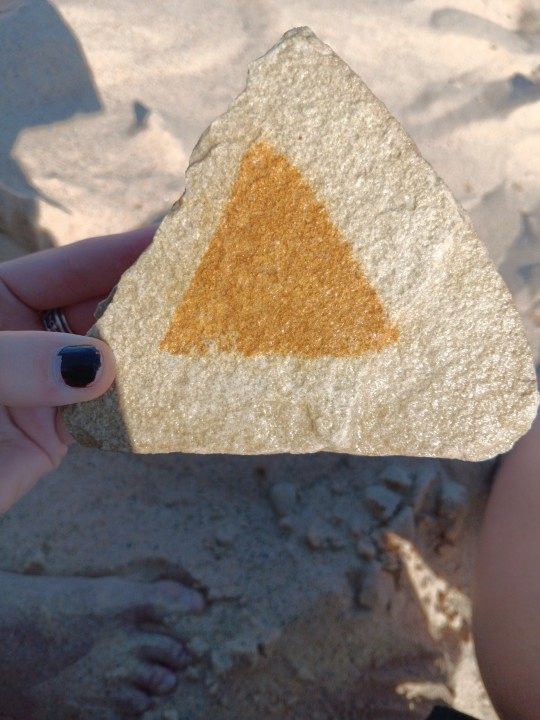
734 notes
·
View notes
Text
i just realized how cute it is that gossan and porphy are together because gossans form intrinsically connected to porphyry deposits
#truly the first thing that i was drawn to was that they all have geology names#my posts#outer wilds#my url is a hearthian name
64 notes
·
View notes
Text
I can't even play minecraft like a normal person anymore because every single time I do anything my thoughts are just
"That is K-spar rich granite"
"Andesite is a fine grained intermediate igneous rock and diorite is a coarse grained intermediate igneous rock"
"I like that they included the presence of mica when they were designing the granite texture"
"Hey look at all the clay in the river. DID YOU KNOW THAT CLAY IS EXTREMELY FINE GRAINED SEDIMENT THAT-"
"I love the different rocks that minecraft has added, but I think they should be even more specific. Where's my gabbro, minecraft??? You gave me basalt, now I want gabbro"
"Tuff is pronounced so weird AND IS ALSO A PYROCLASTIC ROCK. DID YOU KNOW THAT"
#my brain keeps shouting rock facts at me#as if i. the owner of said brain. didn’t know them already#this would be a cry for help if I wasn’t having such a good time#minecraft#geology#rocks and things#rocks
145 notes
·
View notes
Text
Hey geologists I need a bit of help with my worldbuilding.
So I'm adding dwarves to my setting but not your typical short stubby fleshy dudes. But rather short stubby rocky dudes. There are three types of dwarves upper crust, mid crust, and lower crust. They grow at different levels in the earth's crust and are made out of different rocks depending on what's available at that level. Like if they're closer to the surface they're made out of rocks and gems and such that naturally grow at that level.
Small issue though I have no idea what grows- forms? At those different levels farther or closer to the surface and I also don't know in what amounts. What's rare and what's common? I imagine diamonds don't grow in the same place as amethyst.
If you guys could help me out it would be much appreciated!
P.s. I did try googling it first but I couldn't find anything.
P.p.s. a visual representation like a rock map or something would be nice but is not required.
P.p.p.s. please don't be mean to me I'm not an expert on rocks I don't know exactly what to search for which is why I'm asking for help.
#geologists#geology#rock#rocks#world building#idk how do I attract geologists to this thing?#pspspsps#info dump#info dump about rocks and stuff to me#obsidian#volcanic#volcanic rock#pyroclastic flow#quartz#amathyst#opal#opals#turquoise#uhhhhh#earth#earth crust#help#science tumblr#geologist Tumblr#please#please help
97 notes
·
View notes
Text
Geology and The Terror
As a geologist who is incapable of turning off their geology brain even while watching shows for fun, one of the things that baffles me a bit about The Terror is why they continuously refer to the landscape as shale when both King William Island and the filming location in Pag, Croatia are dominated by limestone. Given the desolation of the landscape, the geology is rather at the forefront of many scenes so it was fun to try and parse it out as I watched.
King William Island, Nunavut, Canada
According to the official map of the bedrock of the region as published by the Canadian government (Harrison et al., 2015), the entirety of King William Island is mapped as dolostone, dolomitic limestone, and limestone with only minor components of shale, sandstone, conglomerate, and breccia. This is a shelf marine deposit dating back to the Late Cambrian, so this is very old sedimentary rock but younger than most of the surrounding hard rock that composes various parts of the Canadian shield. Notably, the pink units mapped on the Boothia Peninsula are Paleoproterozoic in age (2.5-1.6 billion years old), potentially up to 2 billion years older than the limestones of King William Island.

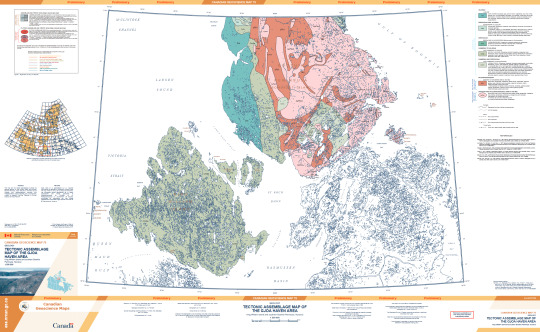
(This is an absolutely massive .pdf file with some scaled features so I would recommend viewing via the official publication to actually read anything or see fine details: publications.gc.ca/pub?id=9.557274&sl=0)
Notably, this map was published in 2015, 8 years after the novel was written. However, according to the bibliography for the map (which can be accessed via the previous link) a preliminary geologic map has existed for the area since at least 1967, though I was unable to track this publication down online. The novel was clearly thoroughly researched and Dan Simmons could have easily accessed this publication and others through multiple institutions.
The surficial geology of King William Island has also been mapped, and is predominantly glacial, as one would expect given it's location. For those unfamiliar with glacial geology processes, this is basically saying that the bedrock is buried under a bunch of glacial deposits. Glacial till is composed of rocks and sediments plucked from the bedrock and ground up. This is why the surface of the island is not one big rock, but a bunch of smaller pieces. Interestingly, the material on the southern part of the island is sandier because it contains more material derived from the Canadian Shield further south. If you're interested in glacial geology, I highly recommend zooming around a bit on Google Earth because the features here are GORGEOUS.
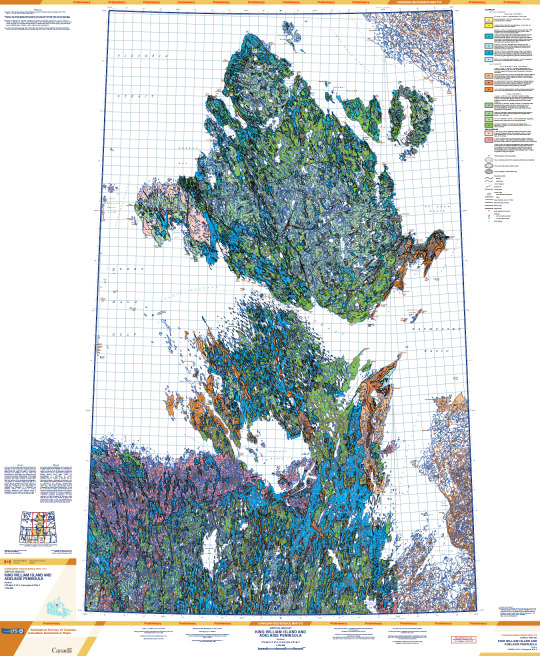
(This map is absolutely massive and the lines scale with zoom so it's hard to see at this resolution, access it here: publications.gc.ca/pub?id=9.834073&sl=0)
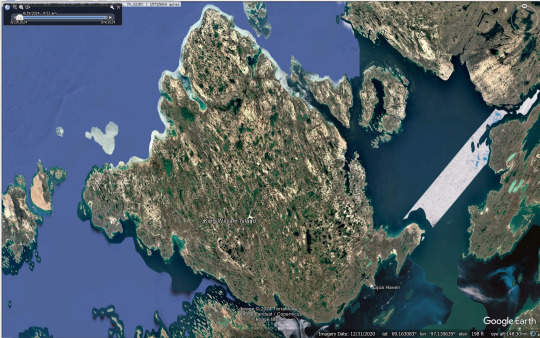
(Google Earth Pro, satellite imagery from 2020)
According to the surface geology map and Google Earth, the actual landscape of King William Island is much more water logged than it appears in the show. It's not entirely impossible that there has been some geomorphological change since 1848, but most of the features mapped would have been formed during the last ice age and as the glaciers melted and not more recently. This would have been handy for the men of the Franklin Expedition because each of these pools is filled with freshwater.
Pag, Croatia
Tracking down a geologic map of Croatia was somewhat challenging as I don't speak Croatian. I was able to find a map of the whole country, and while it's all in Croatian the symbol for the geologic time periods is universal so time periods can be correlated. This shows that the units that make up Pag are Cretaceous and Paleocene-Eocene in age.

(Map accessed here: https://www.hgi-cgs.hr/en/geoloska-karta-republike-hrvatske-1300-000/)
I was able to find a .pdf (access here: http://kig.kartografija.hr/index.php/kig/article/view/158/274) that had a bit more information on the map above but at a lower resolution. This states that the Cretaceous units are dominantly carbonates from the Adriatic sea and the Eocene units are also carbonates. This makes sense as both the Cretaceous and Paleocene-Eocene boundary/PETM are times of increased global temperature correlated with increases in global sea level.
As always, the best geology website out there, Macrostrat, also came through on the unit lithologies. I was unable to access the source listed on Macrostrat, but both the Cretaceous (green) and Paleocene-Eocene units (orange) are listed as limestone.
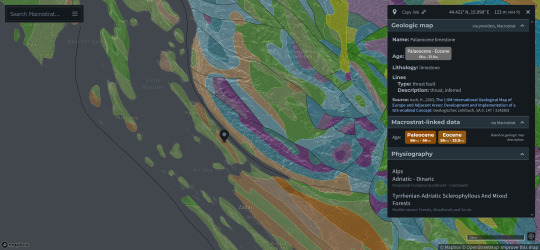
(Source: https://macrostrat.org/map/#x=16&y=23&z=2)
One of the best views that we get of the geology on Pag is the last scene with Bridgens in episode 9. During the zoom out of this scene we get a really nice view of the bedrock and debris covering it.
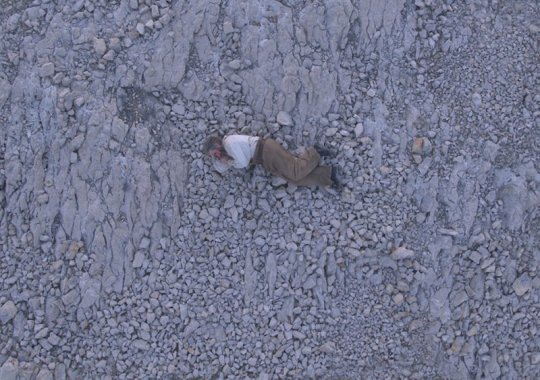
Given all of this, I'm really not sure where the landscape description as shale came from. If there is historical precedence for calling the rocks on the island shale, let me know! I have read a few books but none of the primary sources from the expeditions to this region, so if it comes from that I wouldn't be surprised.
Overall though, I have to say that the filming location was well chosen given the similarities it holds to the geology of King William Island.
#the terror#i have no idea whether this is of interest to anybody else#but i haven't been able to stop thinking about it since i started the show#because obviously the first thing i did was open up macrostrat to see what the geology was like#geology#peter posts#fr though the scene with bridgens is top tier in terms of getting a good view of the geology#it only took me three watches of the show to cave and make a post about it#franklin expedition
135 notes
·
View notes
Text
Melkor’s horrible pickup lines 2 electric boogaloo: The One That Worked.
Melkor: Heyyy Mairon, what did you make your fána out of? Copper(II) telluride?
Mairon: Hm, no, just the usual carbons and nitrogens and stuff. Why do you ask?
Melkor: Oh really? ‘Cause when I look at you, all I see is CuTe.
#mairon: OH MY VOID YOU SPEAK CHEMISTRY TOO???#that’s the day they got married folks.#rip arda#dagor bragollach was their anniversary actually. they had fireworks and everything#all thanks to their shared knowledge of geology and chemistry. ahh the things people can do with the power of love 💕💕#melkor#morgoth#sauron#mairon#silm#the silmarillion#incorrect silm quotes#angbang#dork lords#it ain’t even 12 am yet y’all. looks like brainworms came early
71 notes
·
View notes
Text





💎 Last chance! Ice Cold: An Exhibition of Hip-Hop Jewelry closes January 5, 2025. Visit the Museum to see stunning jewelry pieces that trace the history of hip-hop from the 1980s to today.
💎 Ice Cold is on view in the Meister Gallery in the Mignone Halls of Gems and Minerals, which features more than 5,000 specimens and tells the fascinating story of how minerals arose on our planet and how we use them for personal adornment, tools, and technology.
💎 This show is curated by guest curator Vikki Tobak, and guest co-curators Kevin “Coach K” Lee and Karam Gill. The advisory board includes Slick Rick, LENNY S., Mandy Aragones, Timothy Anne Burnside, Tanisha Ford, Alex Moss, Peter Nice, and Bevy Smith.
💎 Ice Cold is included with any Museum admission. Plan your visit!
#science#amnh#museum#nature#natural history#fact of the day#did you know#gems#minerals#hip hop#geology#jewelry#things to do in new york#nyc#things to do in nyc#ice cold
77 notes
·
View notes